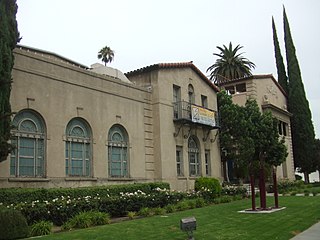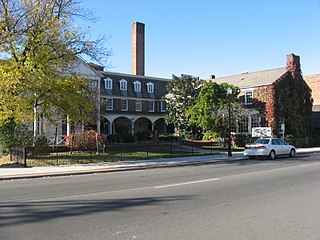
Riverside Art Museum is an art museum in the historic Mission Inn District of Riverside, California. The museum is a non-profit organization which focuses on addressing social issues and offers art classes as well as other events in order to inspire and build community.

The Young Women's Christian Association (YWCA) is a nonprofit organization with a focus on empowerment, leadership, and rights of women, young women, and girls in more than 100 countries.

Asilomar Conference Grounds is a conference center built for the Young Women's Christian Association (YWCA). It is located east of what was known as Moss Beach on the western tip of the Monterey Peninsula in Pacific Grove, California. Between 1913 and 1929 architect Julia Morgan designed and built 16 of the buildings on the property, of which 11 are still standing. In 1956 it became part of the State Division of Beaches and Parks of California's Department of Natural Resources, and Moss Beach was renamed Asilomar State Beach. Asilomar is a derivation of the Spanish phrase asilo al mar, meaning asylum or refuge by the sea. It is the native homeland of the Rumsen Ohlone people.

The former Zanesville YWCA, located at 49 North 6th Street in Zanesville, Ohio, United States, is an historic building built in 1926 for members of the Young Women's Christian Association. It was designed by Howell & Thomas. On July 17, 1978, it was added to the National Register of Historic Places. It is now Bryan Place.

The YWCA Building, located at 25 West Rayen Avenue in Youngstown, Ohio, is an historic building built in 1911 for members of the Young Women's Christian Association. On July 23, 1986, it was added to the National Register of Historic Places. YWCA Mahoning Valley, formerly known as YWCA Youngstown, occupies the building. YWCA Youngstown merged with YWCA Warren on May 1, 2018, to become YWCA Mahoning Valley. YWCA Mahoning Valley also operates a site at 375 North Park Avenue in Warren, Ohio, as well as scattered-site housing in the greater Youngstown area.

The Israel Crane House is a federal-style home located at 110 Orange Road in Montclair, Essex County, New Jersey. The house has had a rich history and was added to the National Register of Historic Places on March 14, 1973, for its significance in architecture, conservation, and industry.

The Young Women's Christian Association in Pueblo, Colorado is a historic YWCA building which was built in 1934. It was listed on the National Register of Historic Places in 1980.

The YWCA, Phillis Wheatley Branch in St. Louis, Missouri is a building dating from 1927. It was listed on the National Register of Historic Places in 1984.

Young Women's Christian Association of Plainfield and North Plainfield is a historic building in Plainfield, Union County, New Jersey, United States.

The Phyllis Wheatley YWCA is a Young Women's Christian Association building in Washington, D.C., that was designed by architects Shroeder & Parish and was built in 1920. It was listed on the National Register of Historic Places in 1983.

The Keokuk Young Women's Christian Association Building is a historic building located in Keokuk, Iowa, United States. It was listed on the National Register of Historic Places in 2004.

Ottumwa Young Women's Christian Association , also known as Your Family Center, is a historic building located in Ottumwa, Iowa, United States. Its significance is related to the local social movement that provided a safe place to live for young women and education programs that encouraged their business and professional development. The Young Women's Christian Association (YWCA) was established in Ottumwa in 1894 by 64 charter members. They began with opening reading and rest rooms before they opened a boarding house. In 1903 they acquired the former First Baptist Church building for their use. They cooperated with the local Young Men's Christian Association (YMCA) for recreational and camping activities. The YMCA built a new larger facility in 1921 and the YWCA considered buying their old building, but they decided to build their own building instead.

The YWCA Building in Peoria, Illinois was built in 1928. It was designed by Hewitt, Emerson & Gregg. The building was listed on the National Register of Historic Places in 2007. It sits at 301 Northeast Jefferson Avenue, at the north corner with Fayette Street in downtown Peoria.

Camp Sloggett in Koke'e State Park near Kokee, Hawaii, is a historic site with significance from 1921. It is within state lands but has buildings owned by the Kauai Young Women's Christian Association.

Young Women's Christian Association is a historic YWCA building in Richmond, Virginia. It was built in 1913–1914, and is a three-story, five bay, brick and stone Renaissance Revival style building. The two-story rear block contains the gymnasium. The building features an elaborately designed entry portico with a curved exterior staircase.

The Young Women's Christian Association Building, also known as the Jacques-Miller Office Building, is a historic building in Nashville, Tennessee, USA.

The Young Women's Christian Association is a historic building in Helena, Montana, U.S.. It was built for the local YWCA chapter in 1918, and designed by architect Chester H. Kirk. It has been listed on the National Register of Historic Places since December 27, 1984.

The YWCA of Duluth is a former YWCA building in Duluth, Minnesota, United States. It was designed by architects Frederick German and Anton Werner Lignell and built in 1908 to provide programs and activities for Duluth's young, single women. It contained a gymnasium, swimming pool, cafeteria, meeting rooms, and apartments. In addition to the organization's usual suite of athletics, Bible study, and employment assistance, the YWCA of Duluth catered to the city's large foreign-born population with English and citizenship classes. The building was listed on the National Register of Historic Places in 2011 for its local significance in the theme of social history. It was nominated for its role in local civic development through the YWCA's social welfare efforts.

The Griswold Memorial Young Women's Christian Association, today known as the YWCA Center for Women, is a historic YWCA building in Downtown Columbus, Ohio. It was built in 1929 and was listed on the National Register of Historic Places in 1993. Renovations took place in 1963-64 and 1984. The building was named for Charles C. Griswold, and was a gift of his wife Mary, who donated about $400,000 to the YMCA's building fund.





















